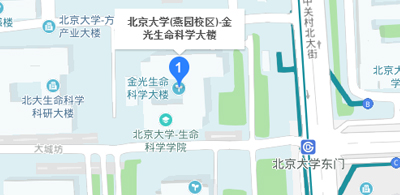Genetic mapping of A-to-I RNA editing in human tissues links population variation and autoimmune disease
报告人:李钦 Ph.D,Stanford University, Department of Genetics
题目:Genetic mapping of A-to-I RNA editing in human tissues links population variation and autoimmune disease
时间:2019年4月10日,10:00 AM
地点:王克桢楼348会议室
联系人:陆剑 研究员(电话:62750246)
欢迎老师、同学们参加!
Abstract:Adenosine-to-inosine (A-to-I) RNA editing plays a vital role in innate immunity, but its regulatory role and functional importance in disease pathogenesis remain largely unclear. Here we mapped the cis-regulatory variants of A-to-I RNA editing (edQTLs) in 49 human tissues from 934 individuals and found that almost ten thousand edited genes were subjected to genetic regulation. edQTLs distribution in Alu repeats aligned with the binding signature of ADAR protein and explained up to 70% of editing level variation. By fine-mapping with disease and complex trait GWAS, we found that edQTLs were strongly enriched in autoimmune and coronary-artery diseases, prevailing over expression and splicing QTLs. Moreover, 40-50% of the phenotype heritability of autoimmune diseases was explained by edQTLs and the partitioned heritability was more than 10-fold enriched over expression QTLs in predicted immunogenic RNA regions. Colocalization analysis pinpointed 25 loci shared between edQTLs and autoimmune disease GWAS signal. Interestingly, the top colocalization signals resided mostly in intermolecular double-stranded RNAs formed by proximal anti-sense transcripts. Our findings illustrate widespread genetic regulation of RNA editing in human tissues, and shed light onto RNA editing-mediated mechanisms in autoimmune disease etiology.
- The Evolution Fluidity of Sex Differences2025.07.22
- Functional Innovation through New Genes Is a General Process in Biology and Evolution2025.07.09
- Spatial Transcriptomics to Target Hidden Drivers for Precision Medicine2025.06.26
- Harnessing big data for precision medicine2025.06.13
- 扦插还是嫁接?双元细胞命运的理论和应用2025.06.13
- Cancer proteogenomics and molecular subtyping2025.05.27
- Mechanism of gene activation in heterochromatin by pioneer factors2025.05.19
- Root Barrier Formation: Walking the Line between Protection and Exchange2025.05.14
- The dark side of eDNA and genotyping by sequencing2025.05.12
- 植物渗透胁迫“复合信号”传导2025.04.28
- Environmental Integration with Root Cell Type Development2025.04.25
- Engineering Longevity – Computationally-Guided Reprogramming of Cell Aging2025.04.10
- 进击的家犬:从起源驯化到医学模型2025.03.26
- RNA Methylation: a Structural Perspective from the Atomic Level to the Formation of an Important Nucleolar RNP Complex2025.03.24
- The Regulation of Hematopoietic Stem Cells and their Niche2025.03.13
- A Core Microbiome Signatureas an Indicator of Health2025.03.07
- Multi-scale control of structural functionality in biological organisms2025.02.25
- Understanding Climate Impact on Plant-Pathogen Interactions2025.02.18
- 第十五届北京酵母研讨会2025.01.09
- 以强农兴农为己任 科技助力乡村振兴2025.01.07
- 铁是大豆结瘤与共生固氮的重要驱动力2025.01.07
- 探寻高油高产大豆的精准设计密码2025.01.07
- 从基础科学到应用科学:突变理论与突变机制驱动的基因工程工具开发2024.12.16
- Phylogenomic Algorithms and Ancient Gene Flow Detection2024.12.16
- 水熊虫耐受超强辐射的多组学景观和分子基础2024.12.06
- The Journey of the HlV-1Capsid: From Assembly to Nuclear Entry2024.12.02
- Molecular mechanisms of auxin-mediated flower initiation2024.11.14
- Bacterial CRISPR and protective Goddess systems involved in antiphage defense2024.11.13
- mRNA and tRNA modifications in the regulation of gene expression2024.11.07
- 大豆光周期开花和株型调控2024.11.06
- Transposable Element-mediated Structural Variation: From McClintock to Pangenomes2024.10.24
- Inter- and intra-cellular signal networks regulating vascular stem cell development2024.10.18
- Structural and Molecular Biology of DNA transfer during Bacterial Conjugation2024.10.18
- Breast Cancer-The Road towards Cure!2024.10.18
- Advancing the Understanding of Ribosome-Inactivating Protein Toxicity for Future Applications2024.10.17
- 北京大学染色质复制国际研讨会2024.10.09
- Targeting membrane proteins with recombinant antibodies from phage display libraries2024.09.10
- 光遗传学-安全精准的新型植物研究技术2024.09.02
- Understanding phloem development cell-by-cell2024.08.29
- Deciphering Human Diseases through Tandem Repeats, Alternative Polyadenylation and Liquid Biopsy2024.07.22
- Landscape of the liver microenvironment in NASH and NASH-associated liver cancer2024.07.12
- Building the RootCellAtlas: A Unified Reference with Unprecedented Spatial Resolution2024.07.02
- An ancient ecospecies of Helicobacter pylori sheds unexpected light on human dietary evolution2024.06.21
- Mitochondrial Retrograde Signaling/Biogenesis - Transcriptional and Post-Transcriptional Levels2024.06.20
- New Gene Evolution Driven By the Force of Sexual Conflict Drive2024.06.13
- Decipher the Epigenetic Code in Health and Disease2024.06.03
- Visualization of Transcription Initiation2024.05.28
- 钙信号在植物生殖中的功能研究2024.05.22
- The Plasticity of Eukaryotic Genomes2024.05.13
- VEGF-B: the Yin and Yang in angiogenesis2024.05.10
- HOW WILDLIFE FIT INTO AN URBANIZED PLANET2024.04.17
- Regulatory Mechanisms of Lipopolysaccharide Synthesis in E. coli2024.04.15
- WHAT CAN CHARMM-GUI DO FOR YOU?2024.04.09
- The essentials of sepsis study - Cultivative or lost 40 years2024.04.03
- 植物中的RNA调控2024.04.01
- Neofunctionalization of Toll signaling: the evolution of dorsoventral axis formation in insects2024.03.22
- 植物代谢的多层次调控2024.03.20
- Recognition of “self”: Uncovering what regulates self-incompatibility in Papaver using transgenic Arabidopsis as a “poppydopsis” SI-PCD model system2024.03.16
- RNA修饰网络的形成和动态调控2024.03.11
- 植物-微生物共生的机制和应用2024.03.11
- 胚胎发育与体细胞重编程的表观调控机制研究2024.02.22
- 空间组学技术开发及应用2024.01.17
- Artificial intelligence to explore multimodality molecular data and accelerate biomedical knowledge discovery2023.12.13
- Biochemical functions of plant NLR immune receptors -from resistosomes to second messengers2023.11.29
- The Hippo Pathway: Signaling and Cancer2023.11.27
- 氨基酸感应与肿瘤微环境2023.11.10
- 计算育种-从“试验选优”向“计算选优”的探索2023.11.03
- Investigating and translating for potential clinical application of molecular mechanisms of genomic integrity2023.11.01
- Tale of a tail-structural insights into protein biogenesis in the ER2023.10.27
- 父系吸烟/尼古丁暴露对小鼠及子代的影响2023.10.27
- 把“冷门” 焐热,让“热门”升华 ——我平凡科研案例背后的科学与人文思考2023.10.27
- The science behind the scientific writing2023.10.16
- 见微知著之肝癌精准诊疗2023.10.10
- 植物根在非生物胁迫下维持生长的分子机制2023.10.09
- 新发再发传染病病原体结构与功能研究2023.09.20
- 光和能量调控大豆共生固氮机制2023.09.14
- CRISPR/Cas13 effectors have differing extents of off-target effects that limit their utility in eukaryotic cells2023.09.14
- Polygenic adaptation in cis-regulation2023.09.14
- A new mode of parental genomic imprinting shapes the genetic control of embryos in plant ancestors2023.09.14
- 表观遗传调控机理与作物遗传育种2023.09.13
- Biogenesis of peptide signals controlling plant defense and development2023.09.07
- ABC模型花发育调控基因的结构保守性和转录后调控机制研究2023.08.11
- How genes become machines in mitochondria2023.07.24
- Secondary siRNA pathways as key regulators of male reproductive development in plants2023.07.18
- Four decades of eukaryotic DNA replication – from yeast genetics to human cryoEM structures2023.07.11
- The “endless forms”: Genetics, development, and evolution of flower2023.07.11
- How supramolecular complexes are assembled for immune defense2023.06.23
- Cryo-EM structures of natively decorated ciliary doublet microtubule and associated complexes2023.06.23
- Coordinated regulation of Na+ extrusion and long-distance transport in plant2023.06.17
- Proximity labeling-driven understanding of plant nuclear membrane function2023.06.07
- Plant sperm cell research and its implementation in biotechnology2023.06.06
- 调控植物碳-氮代谢平衡实现可持续“绿色革命”2023.06.05
- Metabolic Signals in Longevity Regulation Across the Scale2023.05.31
- 植物根可塑性生长发育的机理研究2023.05.22
- From Sensitivity to Specificity: Assembly of the NAIP/NLRC4 Inflammasome2023.05.08
- 植物免疫与病原菌毒性的共进化和广谱抗病重构2023.05.08
- 基因组时代的大豆分子设计育种探索2023.05.08
- Enzymatic DNA Oxidation in the Control of Development and Adaptation2023.04.20
- 植物大孢子母细胞发育机理解析2023.03.13
- 大豆养分高效遗传改良及应用2023.03.09

